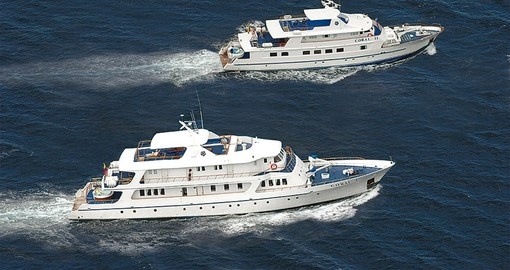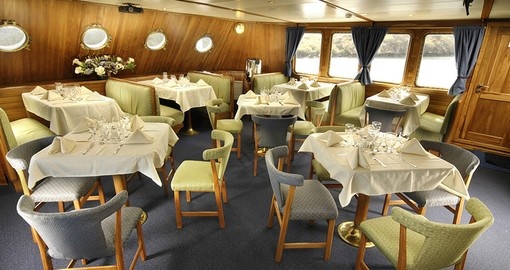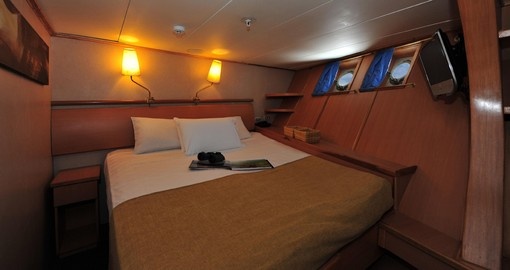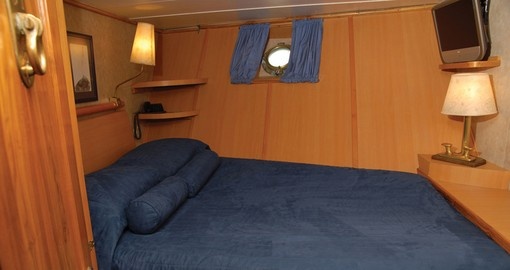Cruising Galapagos: M/Y Coral I: 8 Days
- Duration
- 8 Days
- Prices From:
- AU$ 7,702
Spend 8 days uncovering the natural wonders of the Galapagos Islands. You’ll have the opportunity to snorkel and hike while evenings are spent aboard Coral I, a stylish and luxurious yacht.
For itinerary details please click the above itinerary tab.
Click here for the Galapagos Nature Calendar. A complete listing of which species is doing what and when in the Galapagos!
- Duration
- 8 Days
- Prices From:
- AU$ 7,702
Itinerary View Trip Map
Mainland to Galapagos, San Cristobal
Today marks your departure from mainland Ecuador to Baltra (approx. 2 and half hour flight). You will be picked up at the airport by your guides and taken on a ten minute bus drive to the pier to board the Corals.
Later today you will make a dry landing. San Cristobal is home of the capital town of the Galapagos Province, Puerto Baquerizo Moreno. You will visit the interpretation center, which is an excellent place to learn about the nature and history of the islands, displaying information of Galapagos volcanic origins, their remoteness from the continent, ocean currents, climate, arrival of the original species, among other points of interest. The human interaction is also showcased, chronologically narrating the most significant events about the colonization of the islands. Later on a high-intensity hike can be done to visit Tijeretas Hill, a beautiful landscapes ending with a magnificent view of a nearby large frigate bird colony. If there is enough time, a town visit can be planned.
Difficulty level: Easy / Intermediate
Type of terrain: Flat / stairs
Duration: 1 hour visit / 1 hour walk
| Meal Plan | Breakfast, Lunch and Dinner |
|---|---|
| Duration | 7 Nights |
| Accommodation |
M/V Corals |
| Location | View map |
-
M/V Corals
The M/Y Coral I and the M/Y Coral II have a total of 18 and 11 cabins respectively. The Ocean View, air-conditioned cabins have lower beds and private facilities in which matrimonial, double or triple options are available. We have interconnecting doors suitable for families …
The M/Y Coral I and the M/Y Coral II have a total of 18 and 11 cabins respectively. The Ocean View, air-conditioned cabins have lower beds and private facilities in which matrimonial, double or triple options are available. We have interconnecting doors suitable for families or friends traveling together. Each cabin includes: safe, entertainment system with LCD TVs, hair dryer, special bedding in each category, and remodelled furniture in each cabin. Our voltage is set for 110-220 volts/60 Hz.
Facilities
- Barbeque Area
- Pool
- Restaurant
- Sun Terrace
Photo gallery
Photo 1 of 1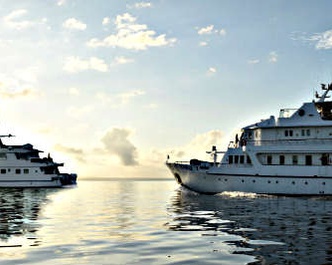
Cerro Brujo (San Cristobal) and Pitt Point
Today, you will start with a wet landing at Cerro Brujo, an eroding tuff cone that at several locations is composed of AA lava formations and a beautiful white sand beach that is ideal for snorkeling and sunbathing. You will visit a lagoon where migratory bird species can be seen including Black-necked Stilts, Ruddy Turnstones, Whimbrels and White-cheeked Pintails. Cerro Brujo offers beautiful views of Kicker Rock, the southern part of San Cristobal and the adjacent coast.
Difficulty level: Easy
Type of terrain: Sandy
Duration: 1 hour walk and 1 hour snorkel
This afternoon, you will make a wet landing on Pitt Islet followed by a high intensity hike on rocky terrain. The trail includes an olivine beach 90 meters long and a path that climbs to the top of a volcanic tuff, passing several magnificent viewpoints along the way. This is probably the only site where the three booby species of the Galapagos can be seen together. This is an excellent area for dinghy rides and snorkeling as a wide variety of sea birds can be observed.
Difficulty level: Difficult
Type of terrain: Rocky and steep
Duration: 2.5 hour walk
| Meal Plan | Breakfast, Lunch and Dinner |
|---|
Suarez Point and Gardner Bay (Espanola)
Today, you will start with a dry landing at Suarez Point, Espanola, an island of geological interest, being one of the oldest in Galapagos, it has a high percentage of endemism due to its isolation from the rest of the islands. Due to the great variety of wildlife, this is one of the most attractive spots in the Galapagos. Here, it is possible to explore volcanic formations and see large colonies of sea lion and seabirds including the Espanola mockingbird, Nazca boobies, and the spectacular red-billed tropicbirds. Here, the singular marine iguanas have a turquoise color with reddish parts during the breeding season, lava lizards, and the colorful Sally light-foot crabs. A somewhat lengthy hike brings visitors to nesting grounds that sometimes overlap the trail. Other birdwatchers favorites include the Galapagos dove, the Galapagos hawk, swallow-tailed gulls and the world's largest colony of waved albatross, an unequivocal highlight during mating season (April-December). Admire the island's dramatic backdrop, featuring the famous "Soplador", a seaward blowhole that shoots water up to 23 m. (75 ft.) into the air.
Difficulty level: Difficult
Type of terrain: Rocky ground
Duration: 2.5 hour walk
This afternoon, you will make a wet landing on Gardner Bay, a beautiful white coral sandy beach guarded by a colony of sea Lions. Here, there are no trails, so visitors stay along the shore, spotting the Galapagos hawk, the American oystercatcher, the Galapagos dove, hood mockingbirds, yellow warblers, lava lizards, marine iguanas, and three species of Darwin finches , cacti finch (Geospizafuliginosa), the small ground finch (Geospizafuliginosa) and the warbler finch (Certhideaolivacea). Swimming and snorkeling offers a great variety of Galapagos marine wildlife: king angelfish, creole fish, damsel fish and parrot fish.
Difficulty level: Easy
Type of terrain: Sandy
Duration: 1 hour walk / 1 hour snorkel
| Meal Plan | Breakfast, Lunch and Dinner |
|---|
Cormorant Point, Devils Crown, Champion (Floreana)
You will start the day with a wet landing, on an olivine green, sanded beach. Hike from the black mangrove beds to a brackish lagoon, which usually holds one of the largest flamingo populations in the Galapagos. This island features some endemic plants such as Scalesia villosa, white and black mangrove, and holy stick. The trail continues to a beautiful white sandy beach, one of the most important nesting sites of Green Pacific Sea Turtles. It is important to avoid walking in the water due to the Sting Rays that may be hiding in the sand, which can be dangerous if accidentally stepped on. From the beach, one can spot sea turtles, blue-footed boobies plunging into the water, and small reef sharks floating along the shoreline in the search for food.
This coral-sand beach marks the end of our trail, and we head back to the olivine beach we landed on, to swim or snorkel amongst sea turtles, reef fish, sea lions and, on a good day, white-tipped reef sharks. A small colony of penguins resides on Floreana and can sometimes be observed as well.
Difficulty level: Easy
Type of terrain: Sandy and flat
Duration: 1 hour walk / 1 hour snorkel
Later today, you will make a wet landing to visit Post Office. Located on the north side of Floreana, the bay was named because in 1793 Captain James Colnett installed a wooden barrel which served as an informal post office for sailors passing through, who would take letters with them back to their destinations. Today, visitors continue the tradition by placing unstamped postcards inside the barrel, hoping that some other traveler, going to the letter destination, will take it back for free. The chances are that the letter posted can take a long time to arrive at its destination. However, there have been cases where it has arrived before the sender.
We may also encounter Darwin's finches, Yellow Warbler and Lava Lizards. Great snorkeling opportunities with Green Pacific Sea Turtles. As well, the island is best known for its endemic vegetation: Scalesia villosa, Lecocarpus Pinnatifidus, and the Galapagos Milkwort. Snorkelers can practice on the main beach among playful sea lions.
Difficulty level: Easy
Type of terrain: Sandy
Duration: 30 minute walk / 1 hour snorkel
| Meal Plan | Breakfast, Lunch and Dinner |
|---|
Highlands Tortoise Reserve and Fausto Llerena Breeding Center (Santa Cruz)
This morning you will have a dry landing. In the mountains of Galapagos is possible to admire different kind of birds, such as: tree and ground finches, vermillion flycatchers, paint-billed crakes, yellow warblers, and cattle egrets (usually standing on the tortoises' shell). The journey to the reserve offers great opportunities to see the contrasts that the island offers in reference to the variety of ecosystems. The road goes from the coast through the agricultural zone and straight up to the dense humid forests. Often, Galapagos Giant Tortoises are also seen on the way, wandering through pastures in the paddocks. This spot is a birdwatchers' haven, since almost every land bird present on the island lives or migrates here.
Difficulty level: Easy
Type of terrain: Flat and muddy (depending on season)
Duration: 45 minute drive / 1.5 hour walk
In the afternoon, make a dry landing on Santa Cruz for a visit to the Galapagos giant tortoises breeding program, where the famous Lonesome George (last surviving specimen of Pinta Island) lived for decades. The center is conducted by the Galapagos National Park staff with the collaboration of scientists from the Charles Darwin Station. Here, eggs taken from Pinzon, Santiago and Santa Cruz Islands hatch without the danger of introduced species. After artificial incubation; the "galapaguitos" (newborn tortoises) are reared until the age of 5, when they are released in their native habitats, having the capabilities to survive alone. Since the 70s, more than 2000 specimens have returned to their own islands. In addition, the Darwin Station works in several scientific projects, botanical research, providing environmental education to communities, schools within the Islands and tourists. If there is enough time, it is possible to visit Puerto Ayora.
Difficulty level: Easy
Type of terrain: Flat
Duration: 1.5 hour visit
| Meal Plan | Breakfast, Lunch and Dinner |
|---|
Dragon Hill (Santa Cruz) and Bartolome
In the morning, walk by a brackish lagoon to see flamingos. The trail leads across a typical dry zone vegetation. Keeping up until Dragon Hill, there will be an important nesting ground for endemic land iguanas, offering lovely views of the anchored boats and neighboring islands. The forest is home to mockingbirds, Darwin's finches, yellow warblers, and Galapagos doves.
Difficulty level: Intermediate
Type of terrain: Rocky
Duration: 2 hour walk
This afternoon make a wet landing to discover a fascinating landscape formed by different volcanic parasitic cones -lava bombs, spatter, cinder cones - that resembles the moon. Going up to the summit there will be an impressive view of the surrounding islands, including the eroded tuff cone Pinnacle Rock. We also encounter marine iguanas, lava lizards, and blue-footed boobies.
Beach time is a great opportunity to do snorkeling and see the famous Galapagos Penguins, sea turtles and White-tipped Reef Sharks among a great variety of colorful fish. For many visitors, this may turn out to be the best snorkeling experience. Crystal clear water is the perfect spot to appreciate the incredible marine life it has to offer.
Due to its geographical location, the lack of vegetation is immediately noticeable however, there are pioneer plants including the endemic Tiquilia nesiotica and Chamaesyce (known as sand mat or spurge in English), lava cactus, and Scalesia bushes.
Difficulty level: Intermediate
Type of terrain: Trail made of 372 steps
Duration: 1.5 hour walk / 1 hour snorkel
| Meal Plan | Breakfast, Lunch and Dinner |
|---|
Rabida and Santiago Islands
This morning you will explore Rabida, also known as Jervis Island in English, one of the most diverse in terms of volcanic activity as it lies at the very heart of the archipelago's volcanic origin. In this deep red beach, surrounded by cliffs and steep slopes of volcanic cinder cones it is usual to find nesting colonies of brown pelicans, as well as, nine species of Darwin finches, fur seals, and Nazca boobies.
Snorkel off the coast, where marine life is particularly active and colorful.
Difficulty level: Easy
Type of terrain: Sandy
Duration: 1.5 hour walk / 1 hour snorkel / 1 hour dinghy ride
During the afternoon, you will visit Buccaneers Cove / Espumilla Beach in Santiago Island.
This is an amazing location, featuring the remains of an eroded shoreline that is home to seabirds, fur seals and the playful sea lions. Its different shapes have been made throughout a process caused by erosion of the waves and the wind. Espumilla Beach is a white-sandy beach in James Bay and is a popular place among visitors. There are mangroves and a small palo santo forest that lead to salty-water lagoons that are home to wading birds like flamingos. In the upper dunes are a nesting site for sea turtles. A good place to snorkel to see rays.
Difficulty level: Easy
Type of terrain: White sand
Duration: 1 hour walk / 1 hour snorkel / beach time
| Meal Plan | Breakfast, Lunch and Dinner |
|---|
Black Turtle Cove (Santa Cruz) and Return to Mainland
This morning enjoy a dinghy ride on the north shore of Santa Cruz Island, accessible only by sea, where four species of mangrove crowd form an internal lagoon. Turtles visit the calm waters, peaking their heads above the surface, while the fish and rays circle below. White-tipped reef sharks can be seen beneath the boat, plus seabirds including pelicans, herons, and egrets feed from the cove.
This cove has been declared as a "Turtle Sanctuary".
Difficulty level: Easy
Type of terrain: None
Duration: 1 hour dinghy ride
Later, transfer directly to Baltra Airport for your return flight to mainland Ecuador.
| Meal Plan | Breakfast |
|---|
Other Information
DEPARTURES:
Itins A/B & C/D - Select Sundays
Itins B/C & D/A - Select Wednesdays
PRICE INCLUDES:
- 7 night cruise aboard the M/Y Coral I or II
- Island transfers
- Local guides
- Meals as indicated
- Domestic airfare
- Park entrance fee
- tourist ticket
PRICE EXCLUDES:
- International Airfare and taxes
- Travel Insurance
- Gratuities unless otherwise stated
- Items of a personal nature
- Optional excursions
- Beverages unless otherwise stated
- Visa fees if applicable
OTHER INFORMATION:
NOTE: The domestic flights Quito - Galapagos - Quito (approx. $550 USD), Galapagos Park entrance fee of $100 USD and visitors ticket of $20 USD are included in the trip price. (Subject to change).
Itineraries: Due to government regulations designed to control and protect the impact of tourism, each vessel, based on length of cruise has its own distinct itinerary. The itineraries are designed to allow visitors to visit all regions of the islands and we suggest you request the advice of Goway's Latin specialists as to which itinerary would suit you best.
13 Dec 2023







